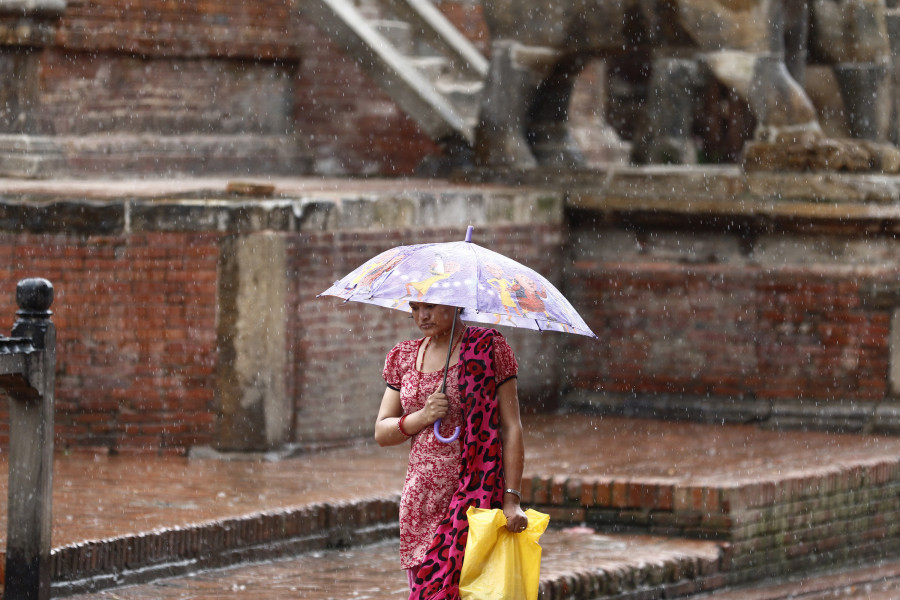Health
As monsoon nears Nepal will have to cope with seasonal diseases and pandemic
As seasonal diseases have symptoms similar to Covid-19, experts warn that treatable conditions may not be diagnosed in time and this may be fatal.
Arjun Poudel
The monsoon is imminent.
Along with the rains, the season also brings a number of diseases. This year with Nepal’s fragile health system battling the second wave of the Covid-19 pandemic, the number of seasonal epidemics will mean a double whammy, especially for rural Nepal.
“The number of new cases of waterborne diseases could rise in the coming days as we have been witnessing heavy rainfall for the last few days,” Dr Tashi Lama, superintendent of Simikot Hospital in Humla, told the Post over the phone.
According to Lama, lately, every day two to three patients suffering from severe diarrheal disease, with their health condition serious, are being admitted to the hospital.
This number is very low compared to previous years as people have been restricted to their homes but this could rise once the prohibitory orders are lifted, he said.
Thousands of people from across the country get ill with dengue, malaria, kala-azar, scrub typhus, Japanese encephalitis, jaundice, typhoid, diarrhea, and cholera during the monsoon.
Scores die, according to the Epidemiology and Disease Control Division.
The monsoon season in Nepal generally begins in mid-June.
“Coronavirus cases too are also rising in the remote villages of the district,” said Lama.
“The number of total positive cases has reached 146 and we have 96 active cases at present in the district,” said Lama. “The coming days will be more challenging for us as we have to deal with all the seasonal diseases and pandemic at the same time.”
Public health experts have warned that at a time when the entire focus of authorities is on containment and management of the rising coronavirus cases, the country could face several other epidemics, which is normal in the monsoon season.
“Apart from containing the spread of ongoing coronavirus infections, we have our regular duties of containing the possible epidemics,” Dr Sher Bahadur Pun, chief of Clinical Research Unit at Sukraraj Tropical and Infectious Disease Hospital, told the Post. “There could be losses of lives from other epidemics too and the authorities should be prepared for the worst.”
Not only in urban centres but also in villages, coronavirus continues to be the focus of health officials.
“We are focussed on containment of the coronavirus cases,” Shankar Duwadi, health coordinator of Benighat Rorang Rural Municipality of Dhading, told the Post. “An outbreak of seasonal epidemic has not been reported yet in our rural municipality but it is not unexpected.”
Along with the seasonal epidemics, severe malnutrition is also seen among the children from the poorest communities in the monsoon season in the rural municipality. People also die from consumption of wild mushrooms, Duwadi said.
According to him, coronavirus infections have spilled over in communities and there are 149 active cases in the rural municipality. So far , five deaths have been recorded from Covid-19 complications there.
On Saturday, Nepal recorded 4,311 new coronavirus infections taking the total infections tally to 553,422. The number of active cases stands at 111,509. With the Ministry of Health and Population reporting 116 new Covid-19 related fatalities, the death toll is 7,163.
Although the number of infections is lower than the near 7,000 mark reported in the last three days, the number of tests was also lower at 14,006 in the last 24 hours compared to about 20,000 in the previous three days. Positivity rate on Saturday was more than 30 percent.
Doctors say what is also worrying is most of the symptoms of the seasonal diseases like dengue, typhoid fever, diarrhoea overlap those of Covid-19.
“Last week, we had a patient who told me that he was suffering from fever, chest pain, body ache but came down with a negative coronavirus report even after undergoing polymerase chain reaction tests three times,” said Pun. “Chances of late diagnosis of diseases and subsequent delay in treatment due to overlapping symptoms could make common seasonal ailments life threatening.”
The World Health Organisation’s global influenza surveillance and response system shows that at least 30 cases of A H3N2, which is known as Hong Kong flu, have been recorded in the country since the beginning of 2021. These symptoms are exactly like those of Covid-19 but the ailment can be treated with timely diagnosis.
In Humla too, several patients suffering from seasonal influenza have come to the hospital for treatment in recent times, according to Lama.
But with the focus on the pandemic, health workers may not be getting the training that they require to treat the seasonal epidemics.
Officials at the Ministry of Health and Population admit that some health workers, who were recently recruited or hired to deal with pandemics, have not been provided training to deal with seasonal diseases.
Earlier, the Epidemiology and Disease Control Division trained medics serving in state-run health facilities across the country, supplied testing kits and kept medicines in stock in view of the outbreaks.
With the implementation of federalism, however, the responsibility of controlling epidemics has come on the provincial and local governments’ shoulders but they too are embattling the coronavirus pandemic.
“Provincial as well as local governments have been provided the budget to deal with the epidemics,” Lila Bikram Thapa, a senior public health administrator at the Division told the Post. “Health agencies under all three tiers of governments have to deal with all possible epidemics, along with the coronavirus pandemic.”
However, all this may simply be too much for the country’s severely stretched health infrastructure.
“Yes, we have to deal with all kinds of challenges,” Dr Samir Kumar Adhikari, joint spokesperson for the Health ministry, told the Post. “Health facilities are ill-equipped, overwhelmed, health workers are in limited numbers but we can’t give up. We have to deal with any potential challenges.”




 6.12°C Kathmandu
6.12°C Kathmandu













%20(1).jpg&w=300&height=200)
